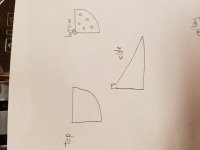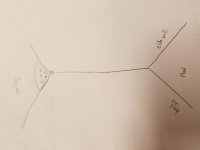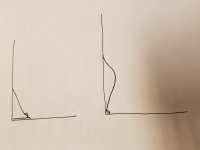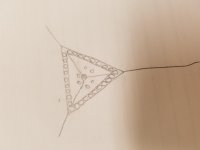I've been thinking about how to integrate a synergy horn into the home environment. Size matters with horns and nobody's wife wants giant horns in their den. Doing a corner line array with the synergy setup would be super expensive and may detract from the whole point source benefit.
So why not have a box that you mount to the ceiling corners, with all the drivers in that box. The horn utilizes the walls to essentially create a gigantic in room horn. No room modifications needed.
The main downside that I see is that all of the ports for the midrange and woofers come from one side of the horn as opposed to multiple like in normal synergy. Also the geometry is challenging because the woofers (lows) need to fit in the box where it is narrowest.
So why not have a box that you mount to the ceiling corners, with all the drivers in that box. The horn utilizes the walls to essentially create a gigantic in room horn. No room modifications needed.
The main downside that I see is that all of the ports for the midrange and woofers come from one side of the horn as opposed to multiple like in normal synergy. Also the geometry is challenging because the woofers (lows) need to fit in the box where it is narrowest.
Attachments
I guess you could have the main volume be further out from the corner, giving you more directional control until it flares out to meet the ceiling, but that transition will cause response issues (unless you can figure out some clever way to use it to your benefit)
Design wise, you could even possibly make it modular, with the ability to add on units for the two side walls that mate to the ceiling unit. Only the ceiling would have the tweeter in the corner though.
Design wise, you could even possibly make it modular, with the ability to add on units for the two side walls that mate to the ceiling unit. Only the ceiling would have the tweeter in the corner though.
Attachments
I have any number of sketches scattered about to optimize the use of corner-loaded synergies. By throwing from the corners of the room, you can look at a smaller horn that neatly transitions from 60/75 degrees out to the LF support conferred by the walls themselves (something like a 120 degree flare). From what I remember modeling in hornresp, if that's done low enough, the intermediate flare is essentially invisible. Also permits easier packaging.
Plus in domestic environments, oftentimes a single mid/woofer is more than enough and you can distribute subwoofers around a-la Geddes (and do well to make them inconspicuous).
Plus in domestic environments, oftentimes a single mid/woofer is more than enough and you can distribute subwoofers around a-la Geddes (and do well to make them inconspicuous).
The B&G neo3 that you are thinking about has a bit of width to begin with. Followed by the spheroidal throat needed to open out the planar wavefront, your waveguide walls will then be a distance from the room walls. This is an issue regardless of the tweeter you choose and the correctness of the throat should probably take precedence over the wall jump distance or the mouth shape vs room wall shape. If the tweeter is allowed to be freestanding it can be made to fit fairly close to the room walls without them being a problem to the highs, fortunately.
I once considered cutting a 10" section from the (dihedral) corner for my lower midrange horn and using the hardwood studs as sides for the rear enclosure and as mounting points. Decoupling for vibration control was a major concern, even though I didn't test it it was a put off. I think it is essential that the mechanical centre requires that the horn not move with regards to the driver motor, and that the box not vary or vibrate with regards to the same.
Putting this horn in the lower trihedral corner was going to present a wavefront that poorly coincided with the ear height tweeter. Another option (just throwing it out there) is to use a three dimensional array to simulate a horn mouth, with the side benefit of offering baffling to what it is wrapped about (the tweeter, for example).
But, I can't see myself wanting a room coincident (built in) tweeter for a number of reasons... The first is that a round compression driver will not correctly meld with the room walls and I feel that the earlier in the horn, the more that correctness is beneficial so I'd rather start round and try to finish before such interruptions, which is easy enough for the highs. Secondly, I have doubts about running highs directly along the room walls as they may be imperfect, and the wavefront would want to be right as well.
Putting this horn in the lower trihedral corner was going to present a wavefront that poorly coincided with the ear height tweeter. Another option (just throwing it out there) is to use a three dimensional array to simulate a horn mouth, with the side benefit of offering baffling to what it is wrapped about (the tweeter, for example).
But, I can't see myself wanting a room coincident (built in) tweeter for a number of reasons... The first is that a round compression driver will not correctly meld with the room walls and I feel that the earlier in the horn, the more that correctness is beneficial so I'd rather start round and try to finish before such interruptions, which is easy enough for the highs. Secondly, I have doubts about running highs directly along the room walls as they may be imperfect, and the wavefront would want to be right as well.
I once ran my lower midrange horn centred just above 2m because I had no space to do otherwise. The physical and electrical crossing was carefully done and it worked very well. I think the reason was that the harmonics were coming from the tweeter which was at ear height. The main reason I pulled it down was to challenge myself to make it more compact.
A Danley SH-50 controls directivity down to 450Hz using a 30" waveguide.
From the research I've been doing lately, it looks like you can accomplish comparable results by wrapping an array around a waveguide and choosing your crossover slopes, frequencies and phase carefully.
This is not a simple project but it looks like you can get directivity control below 450Hz with an array that's as small as about 15" across.
That reduces the footprint of your Synergy Horn by about 75%. (An SH-50 is nearly sixteen cubic feet; a design like what I describe is about four cubic feet.)
Check out Bill Waslo's "small syns" project and my "soundbar bateman style" project.
From the research I've been doing lately, it looks like you can accomplish comparable results by wrapping an array around a waveguide and choosing your crossover slopes, frequencies and phase carefully.
This is not a simple project but it looks like you can get directivity control below 450Hz with an array that's as small as about 15" across.
That reduces the footprint of your Synergy Horn by about 75%. (An SH-50 is nearly sixteen cubic feet; a design like what I describe is about four cubic feet.)
Check out Bill Waslo's "small syns" project and my "soundbar bateman style" project.
Pls explain, how?it looks like you can accomplish comparable results by wrapping an array around a waveguide.
The short answer:
Let's say you put two woofers on the left and the right of a waveguide. They're separated by 6.75". When those two woofers play 1000Hz, they won't radiate anything to the sides. This is because the sound radiating from one woofer will cancel out the sound radiated by the other woofer, and vice versa. (This is because they're separated by one half wavelength, and when two sources are 180 degrees out of phase they cancel out.)
But the cancellation is only to the sides. In front of the array, there's still full output.
In a nutshell, the spacing of the woofers will create an interference pattern.
This will only work over a narrow bandwidth, about one octave. So your woofers will be able to cover about 667Hz to 1333Hz. The center of their output is at 1000Hz.
The net effect is that you can get directivity control down to about 1000Hz with a speaker that's 7" wide. Normally something that small would work down to 2000Hz.
The array lowers your directivity control by about one octave.
You can this even further; nothing stopping you from doing the same thing with a speaker that's 15" in diameter. Things get trickier because the drivers in the array cover a very narrow bandwidth. So a 15" wide speaker would need to be a three way.
Read more here: Soundbar Bateman Style
Let's say you put two woofers on the left and the right of a waveguide. They're separated by 6.75". When those two woofers play 1000Hz, they won't radiate anything to the sides. This is because the sound radiating from one woofer will cancel out the sound radiated by the other woofer, and vice versa. (This is because they're separated by one half wavelength, and when two sources are 180 degrees out of phase they cancel out.)
But the cancellation is only to the sides. In front of the array, there's still full output.
In a nutshell, the spacing of the woofers will create an interference pattern.
This will only work over a narrow bandwidth, about one octave. So your woofers will be able to cover about 667Hz to 1333Hz. The center of their output is at 1000Hz.
The net effect is that you can get directivity control down to about 1000Hz with a speaker that's 7" wide. Normally something that small would work down to 2000Hz.
The array lowers your directivity control by about one octave.
You can this even further; nothing stopping you from doing the same thing with a speaker that's 15" in diameter. Things get trickier because the drivers in the array cover a very narrow bandwidth. So a 15" wide speaker would need to be a three way.
Read more here: Soundbar Bateman Style
If by this you mean that having a mid and tweet with significant physical separation but still the same distance from the listening position, then yes I agree that this is important because the direct sound arrives together, and while you can successfully get away with a fair driver separation, I find it worth taking into account as lobing through the crossover is somewhat like directivity in the single units and it is best blended smoothly and besides, issues that can affect soundstage such as reflections can be accounted for.having phase correct relative to position is much more important to having proper soundstage / alignment than physical placement by itself
Last edited:
- Status
- This old topic is closed. If you want to reopen this topic, contact a moderator using the "Report Post" button.
- Home
- Loudspeakers
- Multi-Way
- Synergy for the home environment



